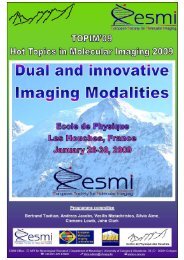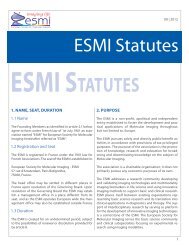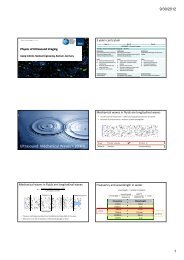5th EuropEan MolEcular IMagIng MEEtIng - ESMI
5th EuropEan MolEcular IMagIng MEEtIng - ESMI
5th EuropEan MolEcular IMagIng MEEtIng - ESMI
Create successful ePaper yourself
Turn your PDF publications into a flip-book with our unique Google optimized e-Paper software.
<strong>5th</strong> <strong>EuropEan</strong> <strong>MolEcular</strong> <strong>IMagIng</strong> <strong>MEEtIng</strong> – EMIM2010<br />
Integrisense: a novel near-infrared fluorescent probe for α v β 3 integrin and its applications in<br />
drug discovery<br />
Sur C. (1) , Lin S.A. (1) , Gleason A. (1) , Kossodo S. (1) , Pickarski M. (1) , Coleman P. (1) , Rajopadhye M. (2) , Duong L. T. (1) , Yared W. (2) ,<br />
Peterson J. (2) , Bednar B. (1) .<br />
(1) Merck Research Laboratories, Westpoint US<br />
(2) ViSen Medical.<br />
cyrille_sur@merck.com<br />
Introduction: The α v β 3 integrin belongs to the superfamilly<br />
of dimeric transmembrane cell adhesion<br />
receptors involved in critical biological processes<br />
such as cell-to-cell, and cell-to-extracellular<br />
matrix binding. As these activities are central to<br />
pathological conditions such as inflammation and<br />
tumor progression, the RGD-binding α v β 3 integrin<br />
has been considred as clinically-relevant biomarkers<br />
of these disease states. Although, RDG peptides<br />
have been developed for PET and SPECT imaging,<br />
the operating cost of these modalities limits their<br />
widespread deployment in drug discovery teams. In<br />
contrast optical molecular imaging allows the noninvasive<br />
monitoring and quantification of fluorescent<br />
probes in vivo with less expensive equipment<br />
that can be installed at multiple research sites. In<br />
order to take full advantage of the rich biology of integrins,<br />
a partnership has been established between<br />
Merck Research Laboratories and VisEn Medical to<br />
develop a novel near-infrared (NIR) fluorescent integrin<br />
probe, IntegriSense TM . The pharmacological<br />
and biological characterization of IntegriSense TM ,<br />
a peptidomimetic antagonist-based molecule with<br />
improved specificity and binding affinity will be<br />
presented together with research applications in the<br />
oncology and atherosclerosis research fields.<br />
Methods: The in vitro cell biology and pharmacological<br />
profiling of IntegriSense TM were conducted<br />
with recombinant HEK-293 cells expressing α v β 3<br />
and included confocal microscopy for cellular localization<br />
and flow cytometry for binding and kinetic<br />
constant determination. In vivo pharmacodynamics<br />
and tumor localization studies were performed<br />
in female NU/NU mice bearing different human<br />
tumor xenografts. IntegriSense TM NIR fluorescent<br />
signal was acquired with a Fluorescent Molecular<br />
Tomography imaging system (FMT2500). The potential<br />
application of IntegriSense TM in atherosclerosis<br />
was evaluated in apolipoprotein E-deficient<br />
(ApoE-/-) and human cholesteryl ester transfer<br />
protein (CETP) knockin/LDL receptor-deficient<br />
(C57BL/6-Tg(CETP)-Ldlrtm1) mice. Transgenic<br />
as well as control C57Bl/6 mice were fed a cholesterol<br />
enriched diet (9% fat, 0.15% cholesterol) to<br />
induce atherosclerosis. IntegriSense TM NIR signal<br />
was measured in vivo 24 and 48 hours after probe<br />
injection and its localization in inflamed aortas was<br />
further evaluated by ex-vivo imaging and histology.<br />
Results: Integrisense-680 has absorption/emission<br />
spectra centered at 674nm/692nm and an extinction<br />
coefficient of 2.02x10 5 M -1 cm -1 . Binding of IntegriSense<br />
TM to HEK-293 stably expressing recombinant<br />
human α v β 3 yielded a Kd of 4.2±0.6 nM and<br />
a dissociation constant koff of 1.08x10 -4 s -1 . Plasma<br />
pharmacokinetic analysis revealed a two compartmental<br />
profile with t1/2 of 6 min and 210 min corresponding<br />
to clearance of free and bound IntegriSense<br />
TM , respectively. Biodistribution studies in<br />
mice with xenograft tumors showed a specific uptake<br />
of IntegriSense TM by tumor cells and supported<br />
using IntegriSense TM to monitor tumor growth in<br />
animal models.<br />
In vivo measurements with FMT2500 in mice atherosclerosis<br />
models detected a longitudinal increase in<br />
IntegriSense TM fluorescence in the thorax area that<br />
was three to five fold higher when compared with<br />
control animals. This NIR signal originated from<br />
atherosclerotic lesions in the aortic arch, carotid,<br />
and subclavian arteries as confirmed by ex vivo imaging<br />
of the dissected vessels and histopathology.<br />
Conclusions: This report demonstrated that the α v β 3<br />
integrin optical reporter, IntegriSense TM developed<br />
by Merck and VisEn partnership can be used as a<br />
molecular imaging biomarker for in vivo imaging<br />
studies. For instance, IntegriSense TM can be used to<br />
monitor tumor growth as well as to detect inflammation<br />
in atherosclerosis plaques. The ability of<br />
this biomarker to report on several important cellular<br />
and physiological functions makes it a tool of<br />
choice to evaluate preclinically the therapeutic potential<br />
of novel anticancer and atherosclerosis drugs.<br />
<strong>EuropEan</strong> SocIEty for <strong>MolEcular</strong> <strong>IMagIng</strong> – <strong>ESMI</strong><br />
day2<br />
Plenary Session on current contribution of IMAGING TECHNOLOGIES to DRUG DEVELOPMENT












